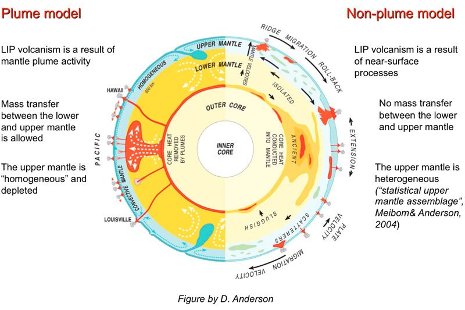Hot Topic in the Earth Sciences: The Mantle Plume Model and Siberian "Traps"

A Michigan Technological University researcher may have solved a long-standing mystery in earth science studies.
In Siberia there exist stepped, large-scale basaltic formations known as “traps.” “Nobody really knew how these were formed,” says Aleksey Smirnov, assistant professor of geophysics at Michigan Tech.
The traps formed about 250 million years ago, at a time that about 90 percent of the species living on earth suddenly became extinct. It has long been suspected this massive set of lava flows was the cause of the extinction. But what caused the lava flows?
With John A. Tarduno of Rochester University, Smirnov has showed that the Siberian traps formed when Siberia was drifting over the Earth’s mantle now underlying the North Atlantic region. The mantle is a rocky, mostly solid layer about 2,800 kilometers (1,700-plus miles) thick between the earth’s crust and its core. Volcanoes are extremely common there, creating Iceland, for example.
Published in the journal Earth and Planetary Science Letters, their research involved detailed analysis of the Earth’s magnetic field directions. Recorded in the rocks from Eurasia and other continents, the magnetic field direction data enabled the scientists to reconstruct the location of the Siberian traps when they erupted.
Most importantly, Smirnov and Tarduno’s work—using a sophisticated mathematical approach—shows that it is likely that a mantle plume or up-welling pushed its way up from the deepest interior of the earth, creating the Siberian traps. Up to now, many geologists believed that some processes in the crust and shallow mantle--called “non-plume” models--were responsible for the formation of Siberian traps.
Not anymore.
“After ten years of research, we have contributed convincing support to the theory of mantle plumes originating near the earth’s core and transporting heat and material to the earth’s surface,” Smirnov says. Their research also suggests that the deeper parts of the earth’s mantle are able to maintain a large chemical or thermal imbalance for hundreds of millions of years.
“We asked, “Why did it appear there in the middle of the Eurasian continent?” Smirnov says. There was enough basalt to cover all of Western Europe with one kilometer of lava—at least three million cubic kilometers. “A deep mantle plume could explain this, but where was it located, and did it survive to the present day?”
Their "pulsing plume" model for the Siberian traps points to an eruption over that same mantle in the North Atlantic. “The same location of the Siberian Trap and North Atlantic eruptions cannot be explained with the non-plume model,” Smirnov says. in addition to publishing their paper, he and his colleagues have discussed their findings at conferences, although not without dispute.
“Overall, this study contributes to better understanding the Earth’s “heat engine” that drives the active tectonics or geological processes of the earth, from earthquakes to mountain-building,” says Smirnov.”It suggests that the necessary energy probably originates from the deep mantle.”
Smirnov also teaches plate tectonics and global geophysics, and the new research feeds right into his classroom. “I can literally tell them the latest findings,” he says. “And they can learn about the importance of scientific debate too.”
Michigan Technological University is an R1 public research university founded in 1885 in Houghton, and is home to nearly 7,500 students from more than 60 countries around the world. Consistently ranked among the best universities in the country for return on investment, Michigan's flagship technological university offers more than 185 undergraduate and graduate degree programs in science and technology, engineering, computing, forestry, business, health professions, humanities, mathematics, social sciences, and the arts. The rural campus is situated just miles from Lake Superior in Michigan's Upper Peninsula, offering year-round opportunities for outdoor adventure.




Comments